-
Animation: The Latent Force of Living Forms
Ars Electronica: Hope, Linz, 2024 -
Installation: The New Times Atlas Of The World
Seoul Mediacity Biennale, Seoul, 2023 -
Sound Design: Whole Earth Codec
Antikythera, Los Angeles / London, 2023 -
Sound Design: Not I
University Of Edinburgh, Scotland, 2023 -
Live Performance: Seven Manifolds
Multiple Locations, 2024-ongoing -
Hurt By The Sun, Linz, 2023 -
Soundtrack: The Beauty Of Becoming
Linz - Bogota, 2022 - 2023 -
Series: Latent Space Divination
Various Locations, 2021 - 2023 -
Speculative Technology: O-CHAIN
A.I.ECOSYSTEMS_ Hackathon, Ars Electronica, Linz, 2021 -
Raumschiff, Linz, 2020-2021 -
Audio. Visuals. Atmosphere., Antwerp, 2021 -
Installation: Remote Landscapes
Can Sisteré, Barcelona, 2021 -
Trust Collective, United States, 2020 -
Universidad Pompeu Fabra, Barcelona, 2020 -
Ritual: Whale Moon
Vibraera, Barcelona, 2020 -
Album: Ybalferran - Our Last Days
Vaaknar, Berlin, 2020 -
Installation: Useless And Necessary
Mixtur, Barcelona, 2019 -
Album: Nine Mountains - Mountain I
Self-publishing, Barcelona, 2019 -
Installation: Balaenofon
Vibraera, Barcelona, 2019 -
Hackathon: Typhoon Dream / Sound Oasis
Urban Sound Symposium, Gent, 2019 -
Music: YOY
Poznań, Berlin, Barcelona, 2016-2021
The Latent Force of Living Forms
Commissioned by servus.at in the context of Ars Electronica.
Techniques: Neural Cellular Automata, Generative Systems, Sound Design.
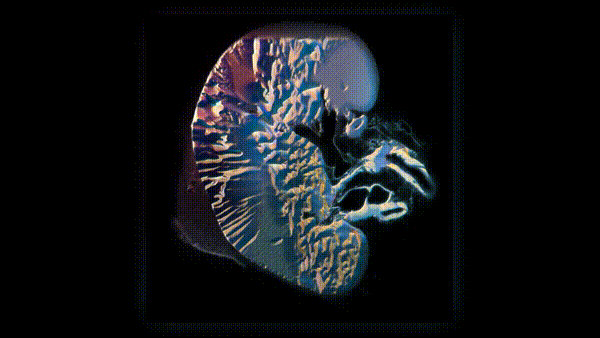
In his seminal paper on morphogenesis, Alan Turing proposed that complex patterns in biological forms arise from the interplay of shared rules and processes, a concept that has since permeated various fields, from biology to socio-political theory. Turing’s foundational work suggests that the beautiful, intricate patterns observed in nature — such as the stripes on a zebra or the spirals of a seashell — are the result of simple rules applied repeatedly across space and time. This principle of emergent complexity has inspired interpretations beyond the biological, influencing how we understand the development of social structures and power dynamics.
Margaret Archer, a prominent sociologist, applies Turing's ideas to the emergence of social structures, emphasizing how individual actions within shared constraints lead to the complex systems that govern societies. Similarly, philosopher Gilles Deleuze suggests that the process of morphogenesis — the emergence and evolution of form — reveals not only how entities adapt and evolve but also how they can undergo malignant transformations. In this context, morphogenesis becomes a metaphor for the unpredictable and sometimes destructive evolution of social and political systems.
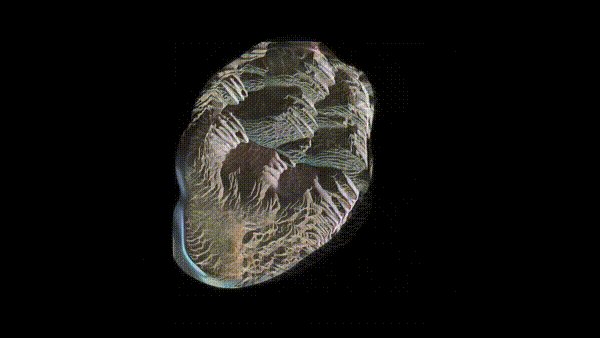
"The Latent Force of Living Form" explores these analogies through the lens of neural cellular automata, a computational model of morphogenesis. The simulation is trained on a dataset of images depicting both healthy and cancerous human tissue, augmented by visual motifs representative of the structures of power that govern modern human life. These motifs include images from various domains — such as cartography, writing, and mineral extraction — that symbolize the forces shaping our world.
In this artwork, each pixel on the screen corresponds to a cell that holds a multidimensional chemical state. The neural cellular automata model learns a set of rules that orchestrate the evolution of these states, leading to a self-organizing phenomenon that reproduces the complexity of the original images. As the simulation unfolds, patterns emerge on the visual plane that reflect the intricate dynamics and latent transformations occurring beneath the surface. These visual patterns, while abstract, highlight the conceptual parallels between biological processes and socio-political ones, inviting us to reflect on the relentless drive for survival and adaptation of these—a drive that can lead to both the emergence and the destruction of the systems that shape our world.

Model
The neural cellular automata model at the heart of this artwork is designed to simulate the process of morphogenesis through a grid of interacting cells. The model's architecture allows it to adapt to different environmental conditions, capturing the dynamic, conditional nature of morphogenesis as described by Turing.
Cell update
In the neural cellular automata model, each cell in the simulation holds a state that is updated at each time step according to a learned set of rules. These updates are influenced by the states of neighbouring cells, leading to the emergence of complex patterns over time. The rules governing cell updates are not hard-coded; rather, they are learned through a training process, allowing the system to develop a nuanced understanding of the different motifs in the dataset.
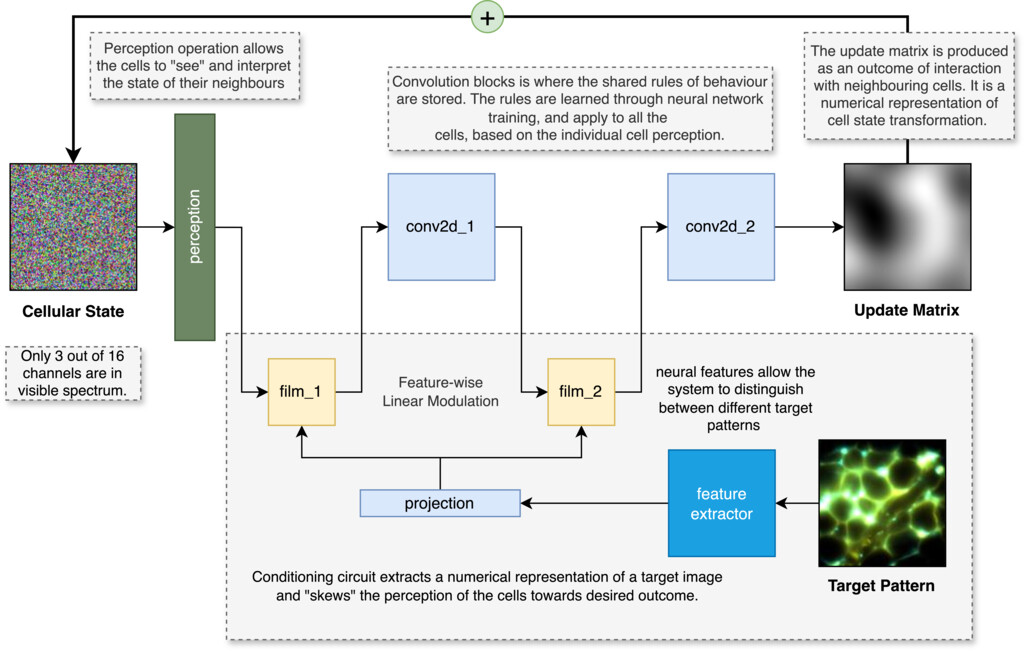
Behavioural adaptability
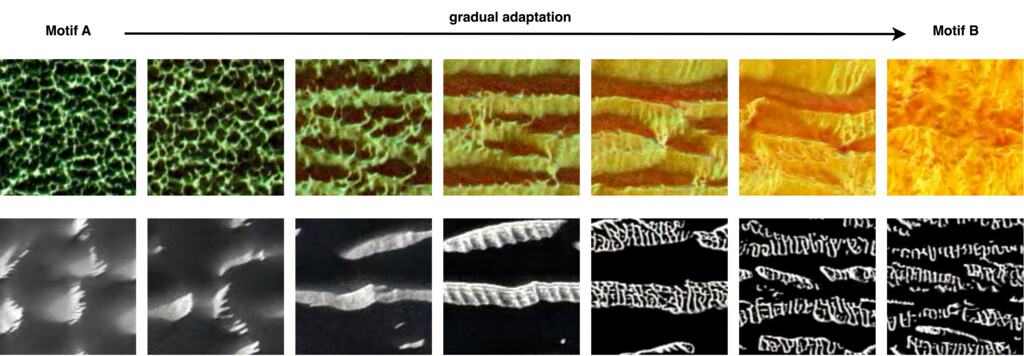
The cellular automata show a high degree of behavioural adaptability, meaning that they can respond to different environmental conditions by changing their behaviour. This adaptability is achieved through Feature-wise Linear Modulation (FiLM) layers, which condition the cell states on the target motifs. As a result, the system can dynamically adjust to the specific characteristics of the motifs on which it is trained on.
Cellular states
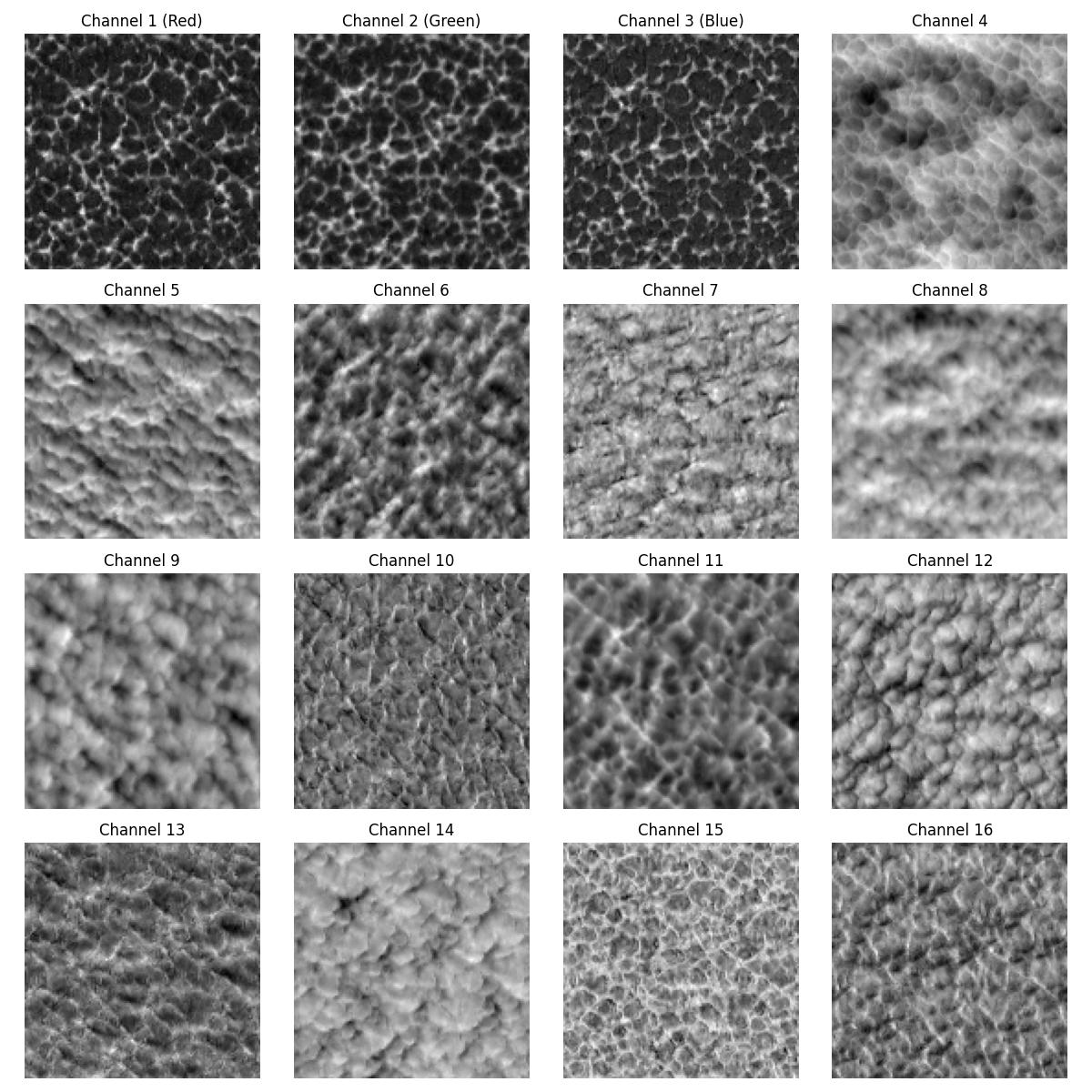
Each cell in the Neural Cellular Automata model maintains a state consisting of 16 distinct values, or channels. Of these, only the first three channels are directly interpreted as red, green, and blue (RGB) colour channels, determining the visible colour of the cell on the screen. These visible states form the patterns that the viewer sees, capturing the superficial phenomena of morphogenesis.
However, the true complexity of the system lies in the remaining 13 channels, which remain invisible to the human eye. These hidden states represent additional dimensions of information that are crucial to the integrity and evolution of the system. While we cannot see these states directly, they play a critical role in determining how each cell interacts with its neighbours, influencing the overall behaviour of the system. These hidden states can be thought of as latent variables—underlying factors that shape the observable outcomes without being directly visible themselves.
Acknowledgments
The technical implementation of neural cellular automata is based on the research in the field of self-organising systems conducted by Alexander Mordvintsev, Ettore Randazzo and Eyvind Niklasson and available at https://selforglive.github.io/.
This project was realized within the context of the JKU LIT project Touching Thoughts, 2024.
A project by Sabina Köfler, Department of Pathology and Molecular Pathology, and Jan Maximilian Janssen, Institute of Anatomy and Cell Biology, JKU Linz,
in collaboration with Davide Bevilacqua & servus.at – Kunst und Kultur im Netz